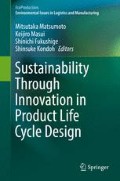Abstract
Minerals and energy have been highly intertwined throughout history, but are becoming even more so with two key emerging trends: the gradual declining grade and increasing depth and complexity of ores and the increasing demand for high-performance functional materials in energy technologies. This paper examines these trends from the perspective of eco-design, focusing on the competing requirements of energy for producing and processing minerals and the demand for minerals in energy technologies. One key element examined is recycling – its impact on supply and the opposing implications of miniaturisation for recyclability of energy technologies. Peak minerals are addressed in conjunction with the implications of nonconventional resources such as deep ocean deposits.
Access this chapter
Tax calculation will be finalised at checkout
Purchases are for personal use only
References
IEA (2013) Energy balances of non-OECD countries. International Energy Agency, Paris
BGS (2010) World mineral production 2004–2008. British Geological Survey, Keyworth
BP (2013) BP statistical review of world energy 2013. Cited 24 Sept 2013. Available from: http://www.bp.com/statisticalreview
USGS (2013) Mineral commodity summaries 2013. United States Geological Survey, Washington, DC
Giurco DP et al (2015) Mineral-water-energy nexus: implications of localized production and consumption for industrial ecology. In: Brau YNAL (ed) The International Sustainable Development Research Society (ISDRS) 21st annual conference – the tipping point: vulnerability and adaptive capacity. ISDRS, Geelong
USGS (2015) Mineral commodity summaries 2015. United States Geological Survey, Washington, DC
McLellan BC et al (2012) Renewable energy in the minerals industry: a review of global potential. J Clean Prod 32:32–44
McLellan BC (2011) Optimizing location of bulk metallic minerals processing based on greenhouse gas avoidance. Minerals 1(1):144–156
WNA (2013) Uranium production figures, 2005–2012. 2013 May. Cited 21 June 2013. Available from http://www.world-nuclear.org/info/Nuclear-Fuel-Cycle/Mining-of-Uranium/World-Uranium-Mining-Production/#.UcOe5y9-OP8
McLellan BC (2015) Sustainability and design considerations for critical minerals in clean energy technologies. In Shibata J, Ahn JW (eds) The 13th Japan/Korea international symposium on resources recycling and materials science. The Resource Processing Society of Japan and Korea Institute of Geoscience and Mineral Resources, Kyoto
McLellan B, Corder G, Ali S (2013) Sustainability of rare earths—an overview of the state of knowledge. Minerals 3(3):304–317
May D et al (2012) Peak minerals: theoretical foundations and practical application. Nat Resour Res 21(1):43–60
Nautilus Minerals (2013) Nautilus Minerals Inc. – Solwara I Project. Cited 8 Apr 2013. Available from http://www.nautilusminerals.com/s/Projects-Solwara.asp
McLellan BC, Motoori R, Tezuka T (2015) Comparison of lifecycle impacts of seafloor mining with onshore equivalents. In: Chung JS (ed) ISOPE 2015. Kona, Hawaii
Corder GD, McLellan BC, Green SR (2012) Delivering solutions for resource conservation and recycling into project management systems through SUSOP®. Miner Eng 29:47–57
Anastas PT, Breen JJ (1997) Design for the environment and green chemistry: the heart and soul of industrial ecology. J Clean Prod 5(1–2):97–102
Allen D, Shonnard D (2002) Green engineering: environmentally conscious design of chemical processes. Wiley, New York
Anastas PT, Zimmerman JB (2003) Design through the 12 principles of green engineering. Environ Sci Technol 37(5):94A–101A
McLellan BC et al (2009) Incorporating sustainable development in the design of mineral processing operations – review and analysis of current approaches. J Clean Prod 17(16):1414–1425
Corder GD, Golev A, Giurco D (2014) “Wealth from metal waste”: translating global knowledge on industrial ecology to metals recycling in Australia. Miner Eng 76:2–9
Acknowledgments
This research was undertaken using a Grant-in-Aid from the Japan Society for the Promotion of Science, Research Project Number: 26701014.
Author information
Authors and Affiliations
Corresponding author
Editor information
Editors and Affiliations
Rights and permissions
Copyright information
© 2017 Springer Japan
About this chapter
Cite this chapter
McLellan, B.C. (2017). The Minerals-Energy Nexus: Past, Present and Future. In: Matsumoto, M., Masui, K., Fukushige, S., Kondoh, S. (eds) Sustainability Through Innovation in Product Life Cycle Design. EcoProduction. Springer, Singapore. https://doi.org/10.1007/978-981-10-0471-1_42
Download citation
DOI: https://doi.org/10.1007/978-981-10-0471-1_42
Published:
Publisher Name: Springer, Singapore
Print ISBN: 978-981-10-0469-8
Online ISBN: 978-981-10-0471-1
eBook Packages: Earth and Environmental ScienceEarth and Environmental Science (R0)

